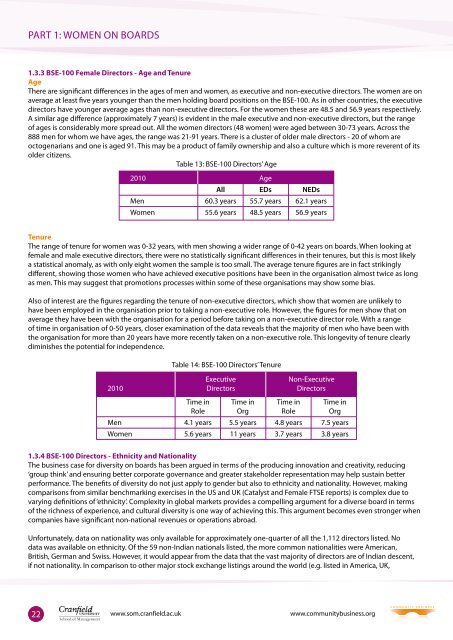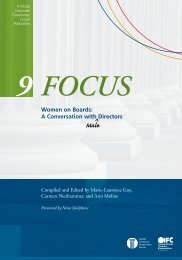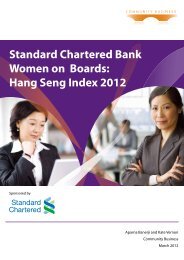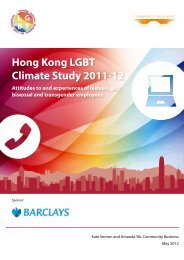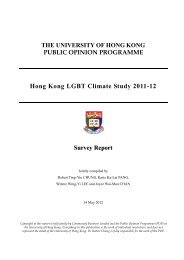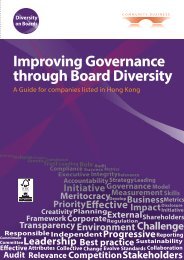Standard Chartered Bank: Women on Corporate Boards in India 2010
Standard Chartered Bank: Women on Corporate Boards in India 2010
Standard Chartered Bank: Women on Corporate Boards in India 2010
You also want an ePaper? Increase the reach of your titles
YUMPU automatically turns print PDFs into web optimized ePapers that Google loves.
PART 1: WOMEN ON BOARDS<br />
1.3.3 BSE-100 Female Directors - Age and Tenure<br />
Age<br />
There are significant differences <strong>in</strong> the ages of men and women, as executive and n<strong>on</strong>-executive directors. The women are <strong>on</strong><br />
average at least five years younger than the men hold<strong>in</strong>g board positi<strong>on</strong>s <strong>on</strong> the BSE-100. As <strong>in</strong> other countries, the executive<br />
directors have younger average ages than n<strong>on</strong>-executive directors. For the women these are 48.5 and 56.9 years respectively.<br />
A similar age difference (approximately 7 years) is evident <strong>in</strong> the male executive and n<strong>on</strong>-executive directors, but the range<br />
of ages is c<strong>on</strong>siderably more spread out. All the women directors (48 women) were aged between 30-73 years. Across the<br />
888 men for whom we have ages, the range was 21-91 years. There is a cluster of older male directors - 20 of whom are<br />
octogenarians and <strong>on</strong>e is aged 91. This may be a product of family ownership and also a culture which is more reverent of its<br />
older citizens.<br />
Table 13: BSE-100 Directors’ Age<br />
<strong>2010</strong> Age<br />
All EDs NEDs<br />
Men 60.3 years 55.7 years 62.1 years<br />
<str<strong>on</strong>g>Women</str<strong>on</strong>g> 55.6 years 48.5 years 56.9 years<br />
Tenure<br />
The range of tenure for women was 0-32 years, with men show<strong>in</strong>g a wider range of 0-42 years <strong>on</strong> boards. When look<strong>in</strong>g at<br />
female and male executive directors, there were no statistically significant differences <strong>in</strong> their tenures, but this is most likely<br />
a statistical anomaly, as with <strong>on</strong>ly eight women the sample is too small. The average tenure figures are <strong>in</strong> fact strik<strong>in</strong>gly<br />
different, show<strong>in</strong>g those women who have achieved executive positi<strong>on</strong>s have been <strong>in</strong> the organisati<strong>on</strong> almost twice as l<strong>on</strong>g<br />
as men. This may suggest that promoti<strong>on</strong>s processes with<strong>in</strong> some of these organisati<strong>on</strong>s may show some bias.<br />
Also of <strong>in</strong>terest are the figures regard<strong>in</strong>g the tenure of n<strong>on</strong>-executive directors, which show that women are unlikely to<br />
have been employed <strong>in</strong> the organisati<strong>on</strong> prior to tak<strong>in</strong>g a n<strong>on</strong>-executive role. However, the figures for men show that <strong>on</strong><br />
average they have been with the organisati<strong>on</strong> for a period before tak<strong>in</strong>g <strong>on</strong> a n<strong>on</strong>-executive director role. With a range<br />
of time <strong>in</strong> organisati<strong>on</strong> of 0-50 years, closer exam<strong>in</strong>ati<strong>on</strong> of the data reveals that the majority of men who have been with<br />
the organisati<strong>on</strong> for more than 20 years have more recently taken <strong>on</strong> a n<strong>on</strong>-executive role. This l<strong>on</strong>gevity of tenure clearly<br />
dim<strong>in</strong>ishes the potential for <strong>in</strong>dependence.<br />
Table 14: BSE-100 Directors’ Tenure<br />
Executive<br />
N<strong>on</strong>-Executive<br />
<strong>2010</strong> Directors Directors<br />
Time <strong>in</strong> Time <strong>in</strong> Time <strong>in</strong> Time <strong>in</strong><br />
Role Org Role Org<br />
Men 4.1 years 5.5 years 4.8 years 7.5 years<br />
<str<strong>on</strong>g>Women</str<strong>on</strong>g> 5.6 years 11 years 3.7 years 3.8 years<br />
1.3.4 BSE-100 Directors - Ethnicity and Nati<strong>on</strong>ality<br />
The bus<strong>in</strong>ess case for diversity <strong>on</strong> boards has been argued <strong>in</strong> terms of the produc<strong>in</strong>g <strong>in</strong>novati<strong>on</strong> and creativity, reduc<strong>in</strong>g<br />
‘group th<strong>in</strong>k’ and ensur<strong>in</strong>g better corporate governance and greater stakeholder representati<strong>on</strong> may help susta<strong>in</strong> better<br />
performance. The benefits of diversity do not just apply to gender but also to ethnicity and nati<strong>on</strong>ality. However, mak<strong>in</strong>g<br />
comparis<strong>on</strong>s from similar benchmark<strong>in</strong>g exercises <strong>in</strong> the US and UK (Catalyst and Female FTSE reports) is complex due to<br />
vary<strong>in</strong>g def<strong>in</strong>iti<strong>on</strong>s of ‘ethnicity’. Complexity <strong>in</strong> global markets provides a compell<strong>in</strong>g argument for a diverse board <strong>in</strong> terms<br />
of the richness of experience, and cultural diversity is <strong>on</strong>e way of achiev<strong>in</strong>g this. This argument becomes even str<strong>on</strong>ger when<br />
companies have significant n<strong>on</strong>-nati<strong>on</strong>al revenues or operati<strong>on</strong>s abroad.<br />
Unfortunately, data <strong>on</strong> nati<strong>on</strong>ality was <strong>on</strong>ly available for approximately <strong>on</strong>e-quarter of all the 1,112 directors listed. No<br />
data was available <strong>on</strong> ethnicity. Of the 59 n<strong>on</strong>-<strong>India</strong>n nati<strong>on</strong>als listed, the more comm<strong>on</strong> nati<strong>on</strong>alities were American,<br />
British, German and Swiss. However, it would appear from the data that the vast majority of directors are of <strong>India</strong>n descent,<br />
if not nati<strong>on</strong>ality. In comparis<strong>on</strong> to other major stock exchange list<strong>in</strong>gs around the world (e.g. listed <strong>in</strong> America, UK,<br />
22<br />
www.som.cranfield.ac.uk<br />
www.communitybus<strong>in</strong>ess.org


